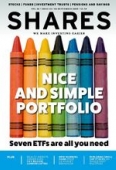Archived article
Please note that tax, investment, pension and ISA rules can change and the information and any views contained in this article may now be inaccurate.
How benchmarks can help to evaluate performance and highlight risk

Imagine setting off on a long journey to the other side of the world and not knowing how long it will take, except you want to complete it in under a year. By identifying staging posts before you set off, you will be better informed about how far along you are at given points in time.
In the same way, you probably have a long-term goal of retiring with a certain amount of money, but how do you know if (for example) the 15% investment return you achieved over the last two years puts you on the right path? Is that a decent return or a great return?
The fund management industry has come up with a variety of ways to answer that question by developing benchmarks. They are useful tools because they categorise funds into buckets with similar objectives and mandates so that an apples-to-apples comparison can be made to assess performance, skill and the level of risk taking.
INDEX BENCHMARKS
Index benchmarking is big business, with the biggest provider, London Stock Exchange (which owns FTSE), having over $16 trillion of assets that use its various indices for benchmarking. Morgan Stanley with its MSCI series and Standard and Poor’s, renowned for its S&P 500 index, are also widely used in the investment industry.
Mainstream actively-managed UK equity funds tend to use the FTSE All-Share index as a benchmark. It is the most comprehensive, covering at least 98% of the capital value of all UK companies eligible for inclusion.
More specialist managers will tend to use sector-specific benchmarks which cover the narrower segment of the market where they are focused.
RISK MANAGEMENT
You can’t beat the FTSE ALL-Share by investing in all 780 stocks that make up the index, as it would be too costly and your results would be similar to the index itself. Active managers often choose a subset of 50 to 75 of the companies in the index, for example, hoping to avoid the losers and latch on to the winners.
Funds following this approach should see their performance diverge from the index. However, less than 18% of active managers beat their benchmark over the last 20 years according to WM Company.
The divergence of a fund’s holdings from the index can be measured statistically to see how much risk a manager is taking in their attempt to beat the index. This is called the tracking error and the higher the reading, the greater the risk. A similar measure that has come into vogue in recent times is called active share.
Benchmark indices also provide sector and industry breakdowns which fund managers can use to keep tabs on where they differ most from the benchmark and highlights their ‘biggest bets’ and where risk resides in the portfolio.
The whole idea behind benchmarks is to measure like-for-like performance and deconstruct the results to see if the best managers were ‘lucky’ or skilful and the worst ones were ‘unlucky’ or unskilful.
PEER BENCHMARKS
Fund managers are just as susceptible to herd behaviour as individual investors and some observers think this is exacerbated by the use of peer benchmarking. Here all managers with the same benchmark or fund objective are ranked. Top quartile ranking (the top 25%) tends to attract money.
Measuring how managers with the same benchmark perform relative to each other introduces a dynamic which increases the tendency to manage to the middle. The warmth and security of being in the middle of the bunch is very alluring, especially compared with being in the bottom quartile.
This practice has come under pressure in recent years as passive investing has become more popular and active managers have been accused of ‘closet indexing’ while still charging active fees.
STYLE FOCUS
The last type of benchmarking which has developed over the last few years is the type offered by companies like data research firm Morningstar and fund consultancies. These are constructed by summing up the quantitative characteristics of a portfolio.
Terms like Global Large-Cap Blend Equity are used to benchmark similar portfolios. Blend refers to the mix of growth-type shares and value shares, based on quantitative measures.
The driving force behind this development has been an attempt to measure so-called style drift whereby managers inadvertently change tack as market conditions move against them.
KEEP IT SIMPLE
Knowing if you are on track to achieve your long-term investment goals is tricky to gauge over shorter time frames. Choosing a benchmark which has a good fit with your approach and the types of investment you focus upon will help you measure progress while also informing you of the amount of risk you are taking.
The FTSE All-Share is a good benchmark for UK-focused, all market cap-based investors, while for those with a global equity approach the MSCI World index might be a better benchmark.
Two final points worth emphasising are that measuring performance only makes sense over at least three or five year rolling periods and always take into account how much risk was taken to achieve the results.
Important information:
These articles are provided by Shares magazine which is published by AJ Bell Media, a part of AJ Bell. Shares is not written by AJ Bell.
Shares is provided for your general information and use and is not a personal recommendation to invest. It is not intended to be relied upon by you in making or not making any investment decisions. The investments referred to in these articles will not be suitable for all investors. If in doubt please seek appropriate independent financial advice.
Investors acting on the information in these articles do so at their own risk and AJ Bell Media and its staff do not accept liability for losses suffered by investors as a result of their investment decisions.
Issue contents
Editor's View
Feature
First-time Investor
Great Ideas
Money Matters
News
- Saga white knight welcomed by investors
- SDL’s tie-up with RWS offers a compelling story
- Shock resignation of Japan PM hits Nikkei
- US markets flash warning signs with echoes of past corrections
- US Federal Reserve tweaks monetary policy goals
- Beauty website owner prepares for biggest London listing of 2020

 magazine
magazine








